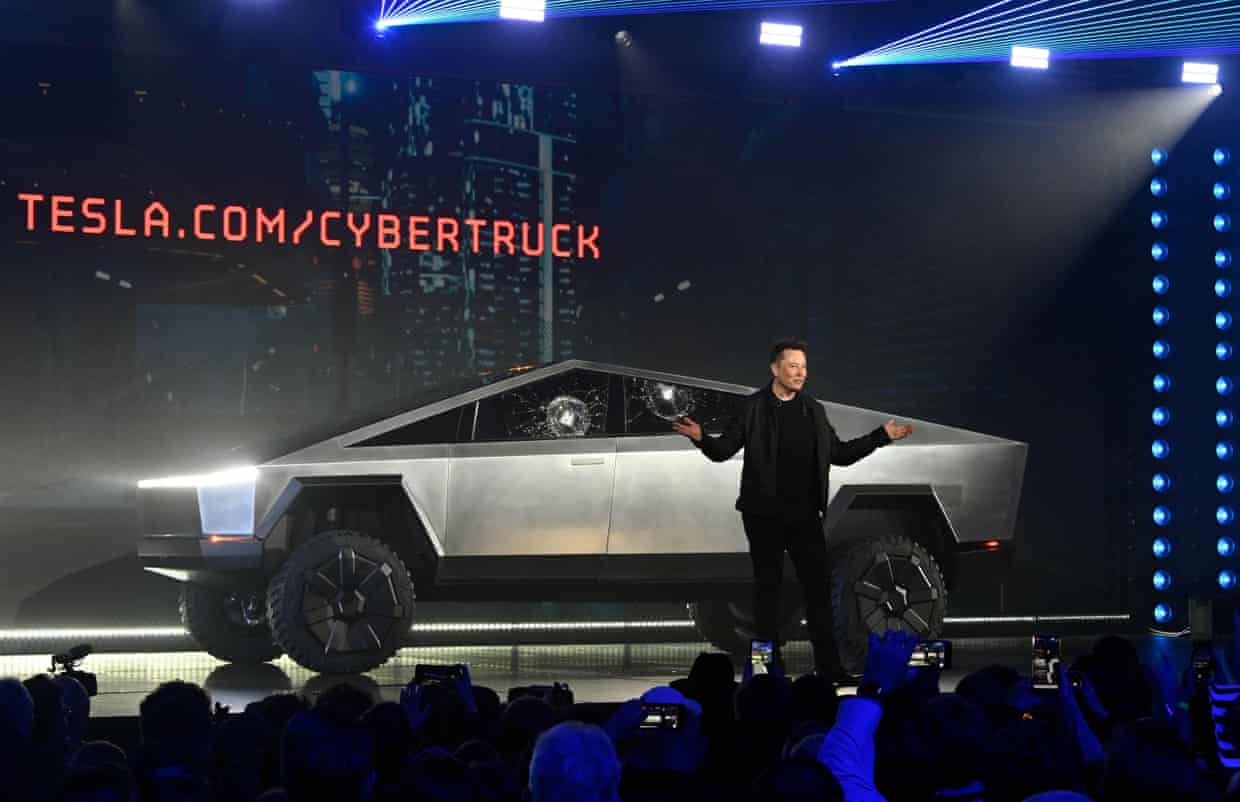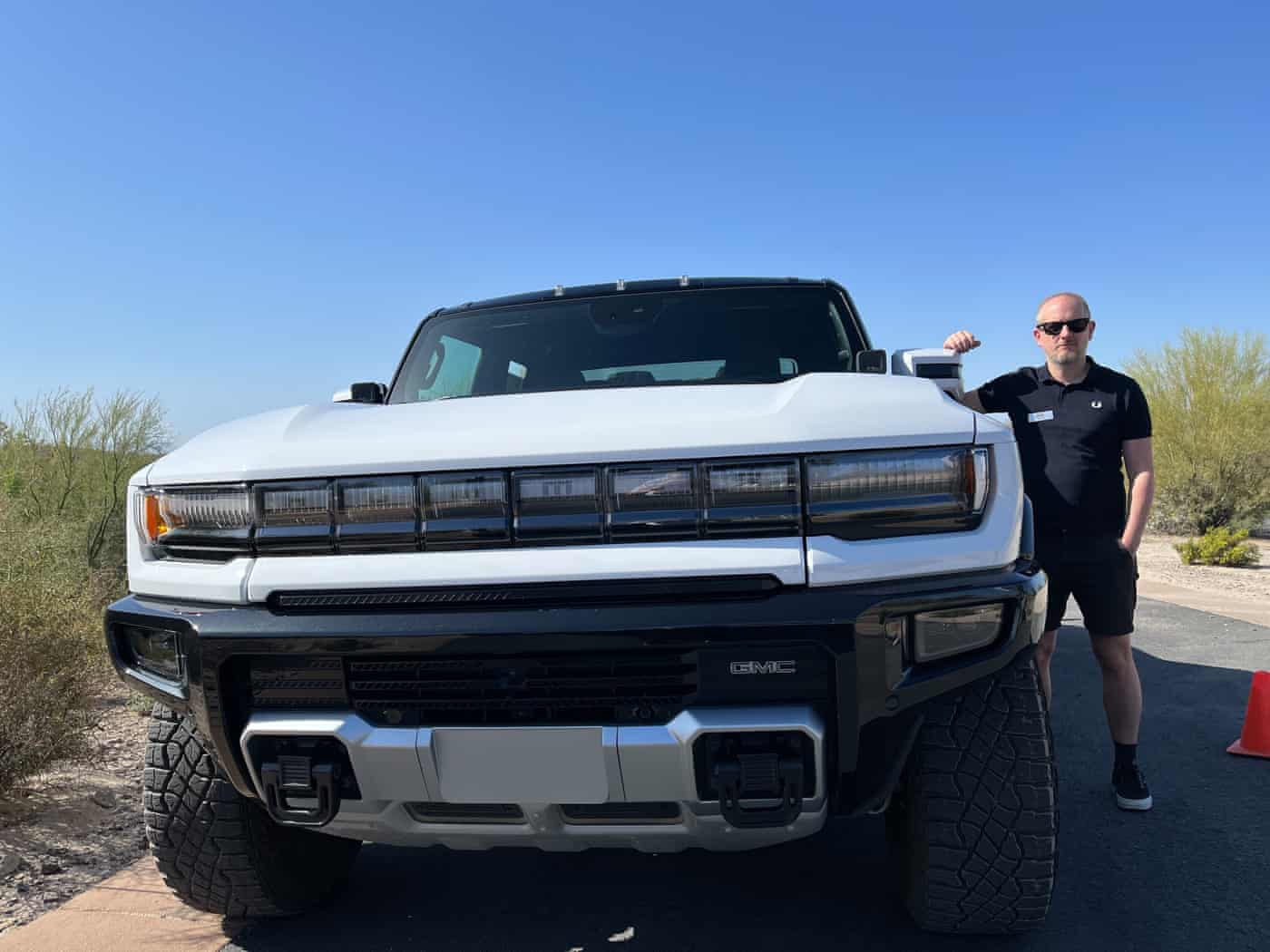GM hopes to crush, under a brawny Hummer wheel, the notion that green cars must look like a Prius. “We want to turn EV skeptics into EV believers,” said Mikhael Farah, a GM spokesperson. This Hummer has even been endorsed as a climate boon by the White House – in November, Joe Biden screeched around GM’s Detroit plant in a Hummer EV. “This sucker is something else!” the president, a self-confessed “car guy”, exclaimed.
I test-drove the all-electric Hummer. Can it win over America’s EV skeptics?
A climate-friendly version of the macho, gas-guzzling pickup is aimed at obdurate devotees of US’s supersized car culture
It is the weight of an elephant, can move like a crab and in a previous life was reviled by environmentalists. The Hummer, that avatar of gas-guzzling machismo, has returned as an electric vehicle with an unlikely billing as an ally in the effort to avert the worsening climate crisis.
The reincarnation of the hulking pickup truck, test-driven by the Guardian in the searing heat of Arizona, has been lauded by manufacturer General Motors (GM) as proof that electric vehicles (EVs) can now reach even middle America’s most obdurate devotees of supersized car culture.
. . .The electric resurrection of the Hummer, first announced in 2020, has produced a vehicle that does not emit the carbon pollution that overheats the planet nor many of the other toxins that routinely kill thousands of Americans, and millions worldwide, who inhale befouled air.
But in many ways it still pushes the boundaries of absurdity. The vehicle weighs more than 4.5 tons, a bulk closer to that of a small bulldozer than the sort of cars typically seen on American streets a decade or so ago. The huge Ultium battery that powers the vehicle is nearly 3,000lb, about the same as two grand pianos. The wheels look like they could traverse Mars. . .
Inside, the Hummer EV is more comfortable than the original and features designs of the moon’s topography – a nod to GM’s role in creating a lunar-roving buggy, which of course was electric – but it maintains a certain butch aesthetic. This points to the Hummer’s broader significance – a demonstration that electric vehicles can now provide the sheer power, size and sensibilities that US buyers cherish, even if they still command only a small fraction of sales.
“What we wanted to do is get a truck buyer who would never buy an EV in his life, or never even think about it,” said Brian Malczewski, a chief exterior designer of the new Hummer.
. . .GM is not alone in attempting this. Ford has announced an electric version of its F-150 truck, which has been the best-selling vehicle in America since Ronald Reagan was president, Tesla has its much-hyped Cybertruck and newcomers such as Rivian have garnered plenty of attention. At a different end of the market, you will even be able to get an electric Maserati this year, even if the price, like many EVs, is eye-watering.

“” said Chris Gearhart, director of NREL’s Center for Integrated Mobility Sciences. “The torque profile of an electric motor will give these vehicles a lot of towing power, and the potential for using some of the electrical power in the batteries to directly power worksites and provide backup power could make these vehicles incredibly useful.”
While EV options are expanding, it’s still unclear whether production levels, and sales, will ramp up with the urgency of the climate crisis. GM has vowed to sell 1m EVs in 2025 before going all-electric a decade later but delivered only 26 electric cars to customers in the final quarter of last year. Toyota wants to sell 3.5m EVs annually by 2030 but currently has none for sale in the US. Public charging infrastructure, meanwhile, remains spotty across the US and Biden’s attempt to fund 500,000 new chargers has yet to be fulfilled by Congress.
Phasing out gasoline cars by 2035, which the US must do if it is reach net zero emissions by 2050 and help avoid climate catastrophe, remains a steep challenge but several experts say replacing them with similar electric alternatives will be the quickest, and most pragmatic, way of slashing emissions from car-dominated American life.
“EVs are by far the best and most economic way to reduce greenhouse gases in transportation,” said Sperling. He added that better public transport, cycle paths and denser housing would be beneficial too but these actions are “far less important for reducing greenhouse gases, at lease in the US and other affluent car-centric countries. . ."
“The Hummer scares me – it’s massive and not compatible with life in cities,” Miller said, adding that SUVs also can be dangerous. “These large vehicles use up a lot of space and are expensive. I’m disappointed that Biden is championing them and not other forms of mobility, such as walking and biking infrastructure. Cars should fill in the niches for some people, not be the default.
“I’m not against EVs – they are the future, but you’ve got to support buses, walking and cycling too or it’s like rearranging the deckchairs on the Titanic. People need options. Unfortunately, car culture is so ingrained that even painting a bike path can get a huge amount of pushback.”
READ MORE >> https://www.theguardian.com/environment/2022/apr/07/electric-hummer-vehicles-climate-crisis



No comments:
Post a Comment